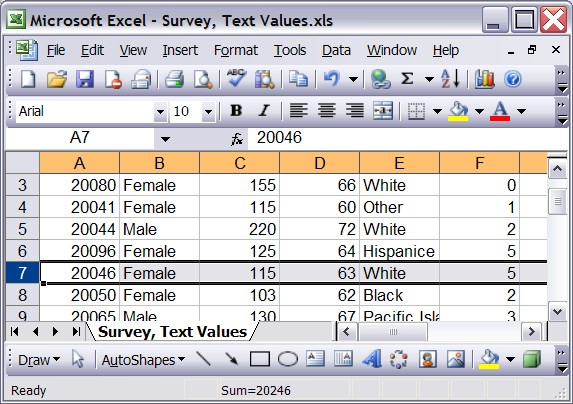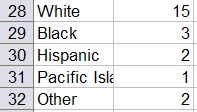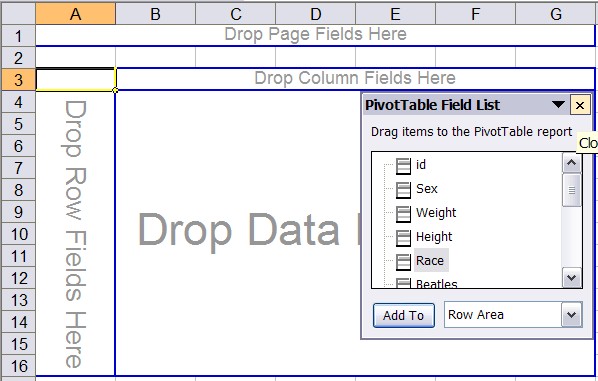3.6. Frequency Charts for Categorical Variables
Often one would like to know the frequency of occurrence of values for a variable in percent. This is similar to a frequency histogram we studies earlier, but a histogram only applies to numerical variables, while the procedure outlines in this section will apply to categorical variables. Unfortunately the procedure is somewhat lengthy, but with a little bit of practice it should not be too bad.Example: A survey was conducted in the summer of 2004, asking several students in a statistics course a number of questions about their background and musical taste. The data can be found by clicking on the link below. Display a bar chart for the race of the students. In other words, compute how many of the students are white, black, hispanic, etc. and display those figures in a bar chart.
Here is the spreadsheet that contains the results of this survey:
Loading this data into Excel, we see that there is one column of interest, entitled "Race". However, that column represents a categorical variable (ordinal or nominal?) so we can not compute a frequency histogram. Also, the values are not numeric so we can't ask Excel to automatically add up all the "hispanics" (for example).Student Survey
But since that column does contain the data we want to display, we need to learn a new procedure for handling categorical data. The procedure should automatically count the frequencies of the various races and present those counts in a bar chart.
Before we figure out how Excel can do this automatically let's simply do it by hand. Inspecting the data we see that there are 5 categories, White, Black, Hispanic, Pacific Islander, and Other. We type these categories into an empty part of the Excel spreadsheet and manually count how many people in each category are contained in our data. We add these counts, or frequencies, next to each category manually:
Now it should be easy to create the appropriate bar chart - make sure to do it, it works just as described in the previous section on creating simple bar charts.
Our manual procedure barely worked because we did not have that much data. For large data sets we need to figure out an automatic procedure to create a table of frequencies and the associated bar chart. Fortunately, Excel has just such a procedure, which we will now explore.
The appropriate tool to create frequency tables for category data is the "PivotTable / Chart Report ..." menu item under the "Data" menu.
For Excel 2007 users: The Pivot tool is found as the first button of the "Insert" ribbon. It has a slightly different interface than shown in the screen shots below but you should be able to figure it out. For detailed assistance - if you are using Excel 2007 - you could try this helpful tutorial.
The PivotTable menu item is actually more flexible than we will need in our course, but it will for sure create the type of tables that we will be interested in. We will, in fact, see that tool again subsequent sections.
- Load the above spreadsheet into Excel and click anywhere inside the data area
- Select "PivotTable Report ..." from the "Data" menu entries (Excel 2007: click "Insert" -> "Pivot Table")

The current default "Microsoft Excel list or database" is what we want, so press "Next". (Excel 2007 skips this step)
- In the next step you will be asked to select the data to use. By default Excel will highlight the entire table present in your worksheet, which is perfectly fine for our purposes, so press "Next". If nothing is entered, select the entire table using the little "selector" icon, as in the Histogram tool. (Excel 2007: the dialog looks different but does the same thing)





